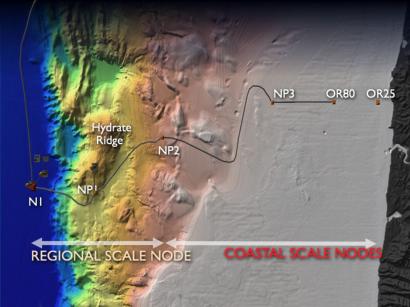OOI Mapping Cruise 2008
Node 1, Hydrate Ridge
Science focused around Node 1, Hydrate Ridge, is highly interdisciplinary.
Interdisciplinary Studies
Node 1 at Hydrate Ridge is a focal point for numerous interdisciplinary studies that address process linkages associated with gas hydrate formation, the flow of carbon from the crust and from the coast to the deep sea, and the linkages among biogeochemical processes and climate change in one of the most biologically productive areas in the world’s oceans. Hydrate Ridge has also been the site of Ocean Drilling Program Legs (ODP) 146 (Site 892) and 204 (Site 1249).
Gas Hydrates
A significant amount of methane near the surface of the Earth is locked into gas hydrates in the shallow sediments on continental margins. The hydrates may act as a capacitor in the carbon cycle by slowly storing methane that can be suddenly released into the ocean and atmosphere during seismic or slope failure. Hydrate Ridge in the Cascadia accretionary complex, is one of the best-studied gas hydrate deposits. Significant methane seeps hosting diverse biological assemblages and formation of gas-rich hydrate deposits near the seafloor have been documented. Studies of these deposits have provided a good understanding of how gas hydrate is distributed in marine sediments and the processes that lead to heterogeneity in distribution.
Dynamic Systems
This site is a clear target for the observatory to define the temporal evolution of these dynamic systems, to determine the fluxes of methane from the seafloor into the ocean, and to understand the biogeochemical coupling associated with gas hydrate formation and destruction. The real-time interactive capabilities of the cabled observatory are critical to studying gas hydrate systems because many of the key processes may occur over short time scales and will require adaptive response and sampling capabilities (e.g. gas hydrate release in response to earthquakes) that include fluid sampling, increases in data accumulation rates and imagery from cameras, and in situ chemical sensors.
Interactive Experiments
The high power and bandwidth capability of the RSN component of the OOI is required to enable man-made perturbations to the system (e.g., fluid pumping; heating of the system to avoid hydrate formation during fluid sampling or to perturb the hydrates), operations that include downhole seismic and/or electromagnetic sources, multi-year deployments that are needed to capture the various time scales operating in this system, and the need for real-time intervention to capture infrequent events or otherwise change experiment parameters that can not be made by passive monitoring.
